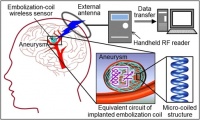It is claimed the method is potentially less invasive and more accurate than current methods, and is simple enough for patients to use at home for frequent monitoring.
According to UBC, brain aneurysms occur when the weak wall of an artery carrying blood to the brain begins to bulge and balloon out. If the artery ruptures the haemorrhage can lead to stroke, brain damage or death. To create a plug that will prevent blood flow to the weak area of the artery, surgeons typically insert an embolisation implant made of microscopic coils of platinum.
UBC researchers have now devised a monitoring technique that is said to be compatible with existing coil-implantation tools and procedures. In the study, the team proved that it is possible to use the platinum implant as an antenna to wirelessly detect blood levels and indicate implant failure. Their results will appear in a forthcoming issue of the journal Biosensors and Bioelectronics.
‘This is a completely brand-new approach to monitoring cerebral embolisation and our tests in the lab have been quite successful,’ said lead author Kenichi Takahata, an assistant professor in the department of Electrical and Computer Engineering.
‘As an early-detection method, what we’re proposing could be carried out by patients at home on a continual basis,’ added Takahata, who led the study with UBC postdoctoral fellow Abdolreza Rashidi Mohammadi. ‘We anticipate having a prototype within two to three years.’
Currently, the only way to check whether an embolisation is still working is to expose patients to high-dose X-rays for a CT scan or angiography — an invasive procedure that involves catheters and injecting dyes to highlight brain arteries.
Aneurysms can occur in any blood vessel in the body and usually cannot be detected unless there is a rupture or leakage. About 33,000 North Americans suffer a rupture every year, leading to stroke with up to a 60 per cent fatality rate and permanent disability in about 50 per cent of the survivors.






Project to investigate hybrid approach to titanium manufacturing
What is this a hybrid of? Superplastic forming tends to be performed slowly as otherwise the behaviour is the hot creep that typifies hot...